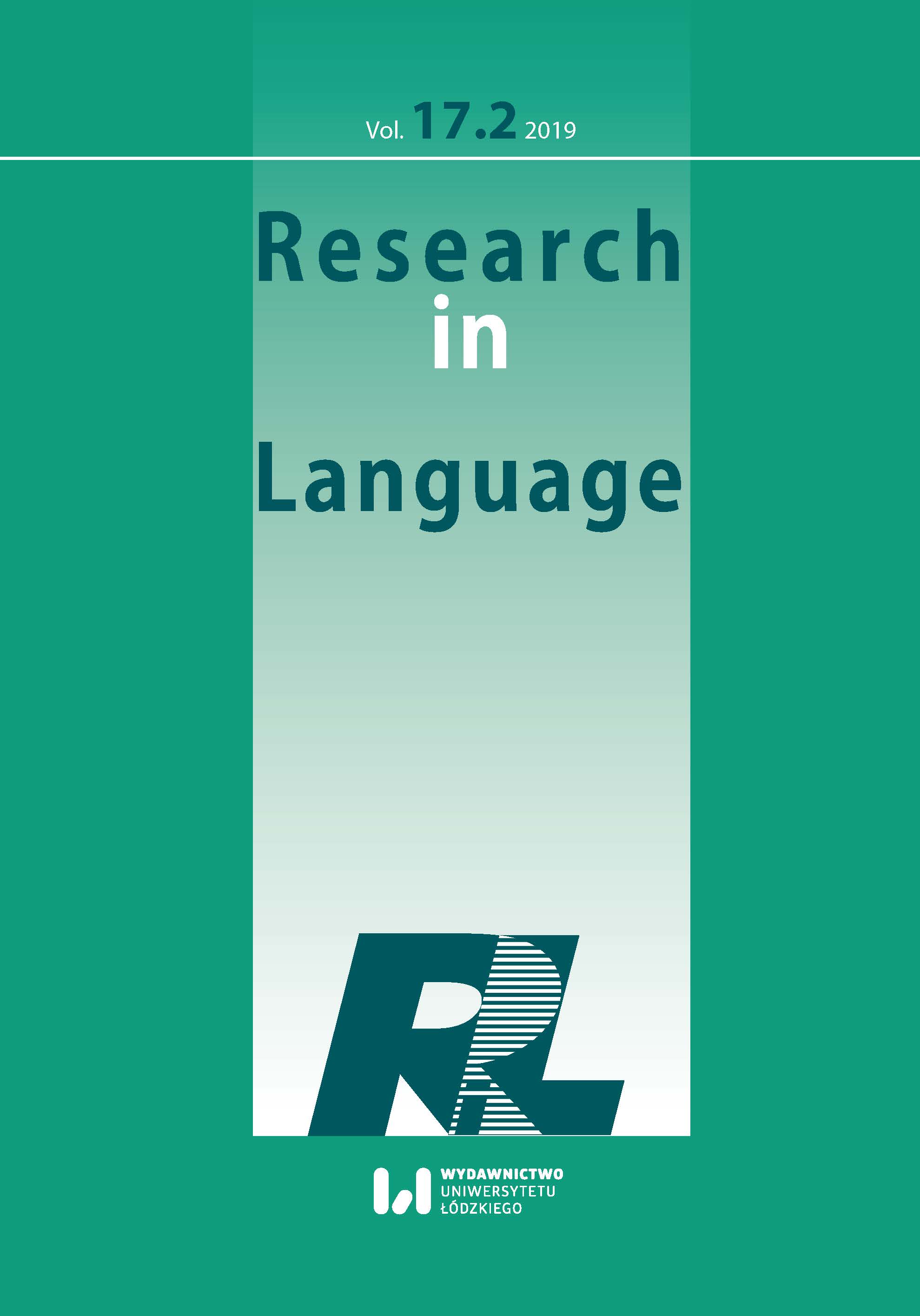The Vowel System of Podhale Goralian
DOI:
https://doi.org/10.18778/1731-7533.17.2.01Keywords:
Optimality Theory, Podhale Goralian, phonology, Polish dialectsAbstract
This paper is a report on the phonological research done in the past two years investigating Podhale Goralian. The data are drawn from our informants in Dzianisz.
The paper establishes the system of surface contrasts in Goralian and identifies instances of complementary distribution. It is claimed that the renowned Podhale Archaism is no longer represented by the vowel [i]. Rather, the vowel has retracted to the central vowel [ɨ]. The original [ɨ], on the other hand, has lowered and fronted and is now best regarded as tense [e]. These transitions of vowels pose challenges for a phonological analysis. A sample of such analysis (Final Tensing) is shown in the framework of Optimality Theory.
References
Avanesov, Ruben Ivanovič. 1968. Russkoye literaturnoye proiznoshenie. Moscow: Prosveshchenie.
Google Scholar
Biedrzycki, Leszek. 1974. Abriss der polnischen Phonetik. Warszawa: Wiedza Powszechna.
Google Scholar
Bilodid, Ivan Konstântinovič. 1969. Suchasna ukraïns’ka literaturna mova. Fonetyka. Kiev: Naukova Dumka.
Google Scholar
Chomsky, Noam and Morris Halle. 1968. The Sound Pattern of English. New York: Harper and Row.
Google Scholar
Clements, George Nick and Samuel Jay Keyser. 1983. CV Phonology. A Generative Theory of the Syllable. Cambridge, MA: MIT Press.
Google Scholar
Decaux, Étienne. 1973. Tzw. archaizm podhalański a sprawa mazurzenia w Małopolsce. Revue des études slaves 49, 119-130.
Google Scholar
DOI: https://doi.org/10.3406/slave.1973.2008
Dejna, Karol. 1973. Dialekty polskie. Wrocław: Zakład Narodowy im. Ossolińskich.
Google Scholar
Halle, Morris. 1992. Phonological features. In William Bright (ed.) International Encyclopedia of Linguistics. Vol. 3. New York & Oxford: Oxford University Press. 207-212.
Google Scholar
Kąś, Józef. 2012. Podstawy ortografii podhalańskiej. In Krzysztof Kudłaciak (ed.), Róźnie tô na tym Bôzým świecie. Bukôwiańskie godki. Bukowina Tatrzańska: Bukowiańskie Centrum Kultury „Dom Ludowy”.
Google Scholar
Kąś, Józef. 2015. Ilustrowany leksykon gwary i kultury podhalańskiej. T. 1. Bukowina Tatrzańska: Bukowińskie Centrum Kultury ,,Dom Ludow’’.
Google Scholar
Kopernicki, Izydor. 1875. Spostrzeżenia nad właściwościami językowemi w mowie Górali Bieskidowych, z dodatkiem słowniczka wyrazów góralskich. Rozprawy i sprawozdania z posiedzeń Wydziału Filologicznego Akademii Umiejętności III. Kraków: Drukarnia Uniwersytetu Jagiellońskiego pod zarządem Ignacego Stelcla.
Google Scholar
Kosiński, Władysław. 1884. Przyczynek do gwary zakopiańskiej. Rozprawy i sprawozdania z posiedzeń Wydziału Filologicznego Akademii Umiejętności X. Kraków: Drukarnia Uniwersytetu Jagiellońskiego pod zarządem Ignacego Stelcla.
Google Scholar
Kryński, Adam Antoni. 1884. Gwara zakopiańska. Studyjum dyjalektologiczne. Rozprawy i sprawozdania z posiedzeń Wydziału Filologicznego Akademii Umiejętności X. Kraków: Drukarnia Uniwersytetu Jagiellońskiego pod zarządem Ignacego Stelcla.
Google Scholar
Małecki, Mieczysław. 1928. Archaizm podhalański. Monografje polskich cech gwarowych 4. Kraków: Akademia Umiejętności.
Google Scholar
McCarthy, John J. and Alan Prince. 1995. Faithfulness and reduplicative identity. In Jill N. Beckman, Laura Walsh Dickey and Suzanne Urbanczyk (eds.), Papers in Optimality Theory. Amherst: GLSA. 249-384.
Google Scholar
Nitsch, Kazimierz. 1915. Dialekty języka polskiego. Kraków: Akademia Umiejętności. and 1957. 2nd edition. Wrocław: Zakład Narodowy im. Ossolińskich.
Google Scholar
Prince, Alan and Paul Smolensky. 2004. Optimality Theory: Constraint Interaction in Generative Grammar. Oxford: Blackwell. [Revision of 1993 technical report, Rutgers University Center for Cognitive Sciences. Available on Rutgers Optimality Archive, ROA-537.]
Google Scholar
Rozwadowski, Jan Michał. 1915. Historyczna fonetyka, czyli głosownia języka polskiego. Reprinted in Jan Michał Rozwdowski, Wybór pism. Tom I. Pisma polonistyczne. 1959. Warszawa: Państwowe Wydawnictwo Naukowe.
Google Scholar
Rubach, Jerzy. 2003. Polish palatalization in Derivational Optimality Theory. Lingua 113, 197–237.
Google Scholar
DOI: https://doi.org/10.1016/S0024-3841(02)00054-2
Rubach, Jerzy. 2011. The vocalic system of Kurpian. Studies in Polish Linguistics 6:81-98.
Google Scholar
Rubach, Jerzy. 2017. Derivational meanders of high vowel palatalization. Lingua 199:1-26.
Google Scholar
DOI: https://doi.org/10.1016/j.lingua.2017.06.015
Sagey, Elizabeth. 1986. The Representation of Features and Relations in Non-linear Phonology. Doctoral dissertation, MIT.
Google Scholar
Schuster-Šewc, Hinc. 1968. Gramatika hornjoserbskeje rĕče. Bautzen: Domowina Verlag. Translated into English by Gary H. Toops as Grammar of the Upper Sorbian Language. 1996. München-Newcastle: Lincom Europa.
Google Scholar
Stieber, Zdzisław. 1952. Rozwój fonologiczny języka polskiego. Warszawa: Państwowe Wydawnictwo Naukowe.
Google Scholar
Stieber, Zdzisław. 1973. A Historical Phonology of the Polish Language. Heidelberg: Carl Winter.
Google Scholar
Stopka, Nazimek, Andrzej. 1897. Sabała: portret, życiorys, bajki, powiastki, piosnki, melodye. Kraków: Drukarnia Narodowa.
Google Scholar
Stopka, Nazimek, Andrzej. 1911. Rycerze spiący w Tatrach: fantazye na tle podań ludowych. Kraków: Drukarnia i Zakład Art.-Litogr. Polonia.
Google Scholar
Downloads
Published
How to Cite
Issue
Section
License

This work is licensed under a Creative Commons Attribution-NonCommercial-NoDerivatives 4.0 International License.










